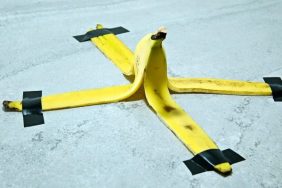Photo: “Jose Parla: Roots,” Young Arts, Miami, Photography by Dylan Wilson.
“My grandfather, pilot Agustin Parlá once said to my father; ‘Son, find your place in History’ and my father said the same to me. And my old friend Don Busweiler once said, ‘Without roots the tree won’t grow.’ This has always stuck with me and remained present in the process of my work over the years.” reveals Cuban-American artist José Parlá (n. 1973).
Also: The Full Showcase of Stories for Art Basel in Miami Beach
Now based in Brooklyn, the Miami Beach native comes home for José Parlá: Roots, currently on view at the Jewel Box at the National YoungArts Foundation, Miami, through December 15, 2016. Presented by Rolls-Royce Motor Cars in partnership with the Savannah College of Art and Design, Roots finds returning to the city where he spent his formative years in the underground art scene of the 1980s and ‘90s, where he embraced graffiti.

“Jose Parla: Roots,” Young Arts, Miami, Photo by Kari Herrin
Over the years, Parlá has become internationally renowned for his ability to capture the natural forms of urban life. Each canvas is a visceral blend of line, color, texture, and form, evoking the raw, weathered surfaces of building after extensive exposure to the elements whether in Cuba, New York, or Miami. Many of the paintings are named for streets in his newly-adopted home including DeKalb, Ashland, Baltic, and Flagler. The works become vast landscapes of that which lays before our eyes unseen, the raw materiality of life that may be continuously beaten by the elements but remains undefeated, still standing strong.
Nuevo Rumbo, a glorious masterpiece, hangs spans 6 x 24 feet in two panels that create an abstract landscape of the history of Cuba from pre-colonial times to the rise of Fidel Castro, invoking the uprising of slaves, the Ten Years War, the Cuban Independence War, and the Cuban Revolution. These histories are told in color and texture, rendered abstractly, invoking a sensory response, using art as metaphor. At the center, where the two panels meet, the painting begins to find a smoother blend, bridging to the current history of President Raul Castro and President Obama negotiating new relations between the United States and Cuba.

Jewel Box exterior. Photo by Greg Clark
With the exception of Nuevo Rumbo, the paintings and sculptures featured in Roots were specially commissioned as a site-specific, immersive installation for the Jewel Box, a stunning piece of sculpture that sits proudly on the YoungArts campus. The façade of this historic building, the former home of the Bacardi family empire, is covered in stained glass, creating four walls of mosaics that proudly face out to the world. The inside, usually ablaze with color and shape, has been completely transformed by Parlá, with carefully considered walls that conceal the stained glass, except in select spaces where they graciously engage with the works, acting as an accent to add quiet touches and flourishes throughout the exhibition.
Roots creates a bridge from the past to the present, allowing history to unfold and come alive through the understanding that the past never truly dies. Instead it lives in us all, whether as manifest through the passage of DNA from one generation to the next, or the primordial nature of cause and effect.

“Jose Parla: Roots,” Young Arts, Miami, Photo by Kari Herrin
Parlá’s place in his family history is set against the backdrop of his native Cuba, which has gone through so many changes over the past century, is the basis for the works in the show. Three of the large scale paintings in the exhibition, Patria, Hatuey, and 24 de Febrero are named for Cuban Navy ships that lent their support to the Audacious Flights of Domingo Rosillo and Agustin Parlá, that artist’s grandfather, in 1912.
Agustin Parlá was one of the first Cuban pilots to make the flight from Key West to Havana in a plance made of bamboo and sugar cane A reporter covering the historical event wrote of Agustin, “… filled with limitless patriotism and a tenacious resolution, he embarked on the trial flight. As the town had followed it from start to finish, they finally learned that the aviator had moved steadily along the ideal course, the one that led to Cuba.”
Thus, as his grandfather before him, José Parlá has come full circle, returning to his roots, embracing the history of his family and his people in the work he creates With paintings titled after Brooklyn streets, including Flagler, Ashland, DeKalb, and Baltic, Parlá creates a dialogue between the past and present that helps us to understand who we are and where we’ve been in order to help guide us towards a better future and ultimately fulfilling his destiny.

José Parlá, Roots. Young Arts, Miami, Photo by Kari Herrin.
Miss Rosen is a New York-based writer, curator, and brand strategist. There is nothing she adores so much as photography and books. A small part of her wishes she had a proper library, like in the game of Clue. Then she could blaze and write soliloquies to her in and out of print loves.






